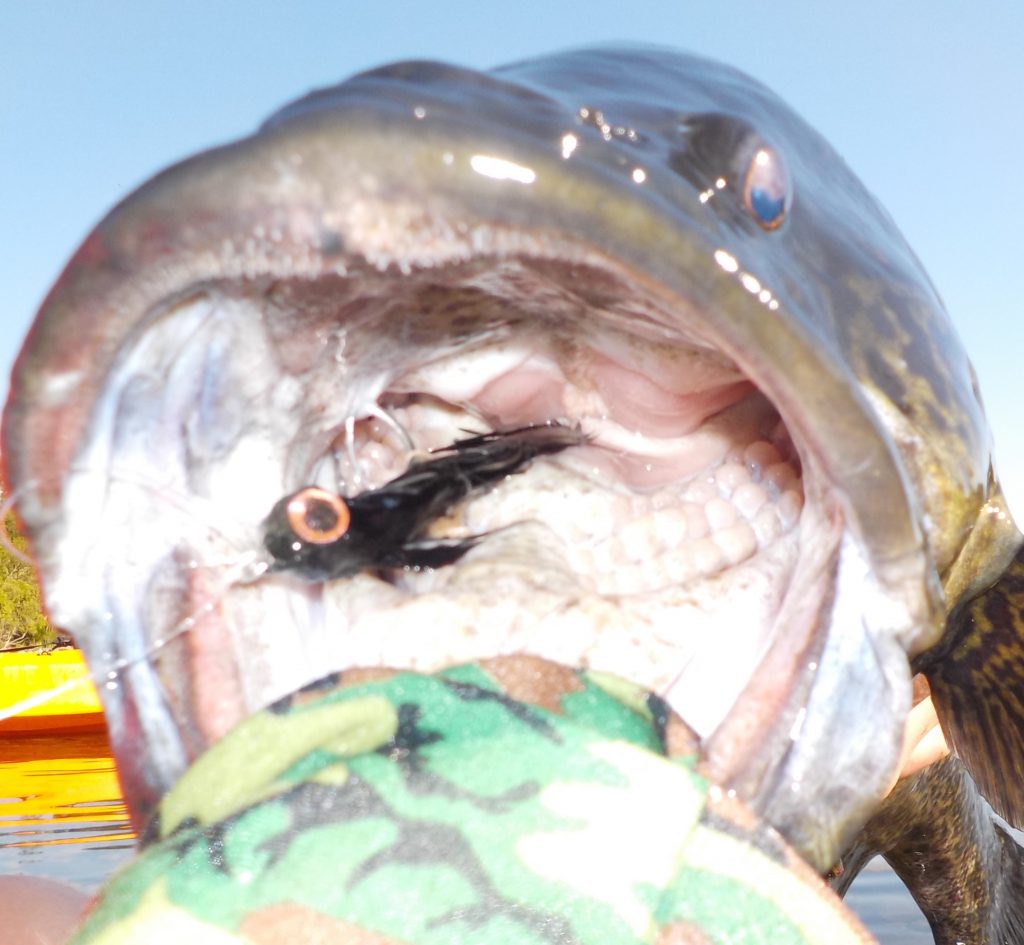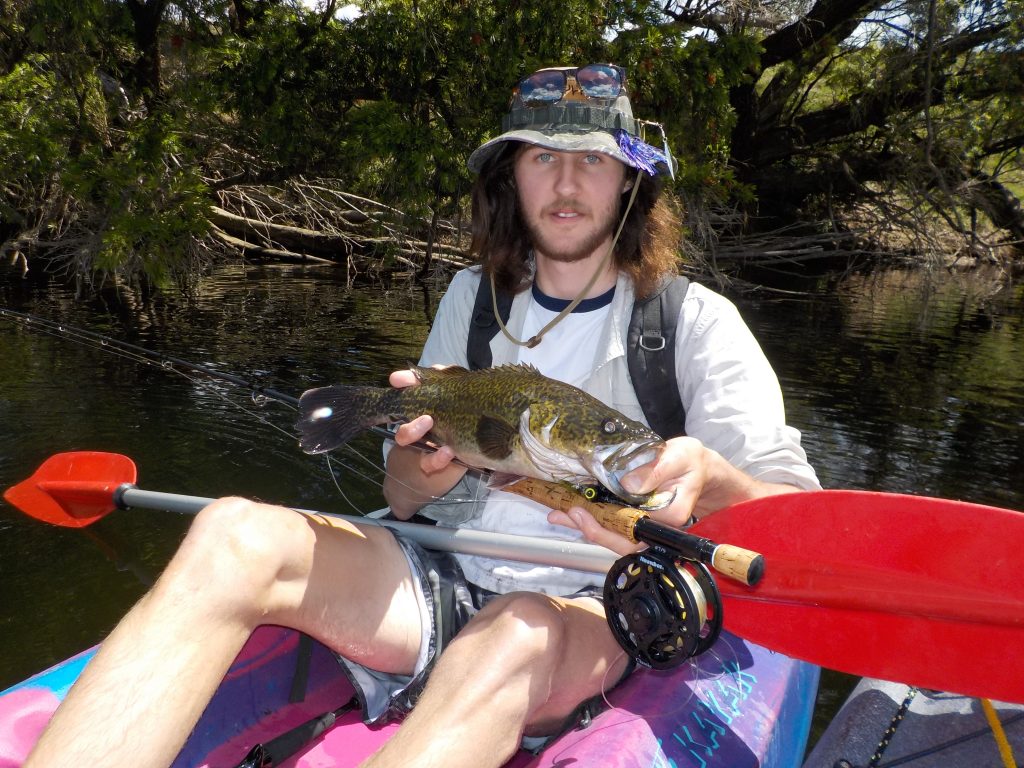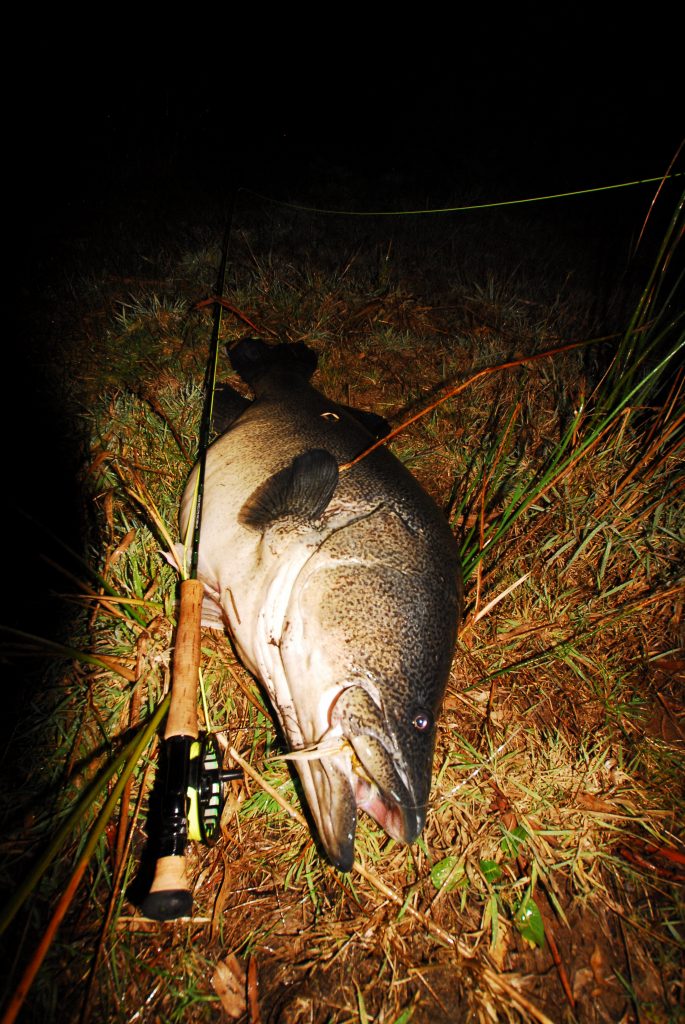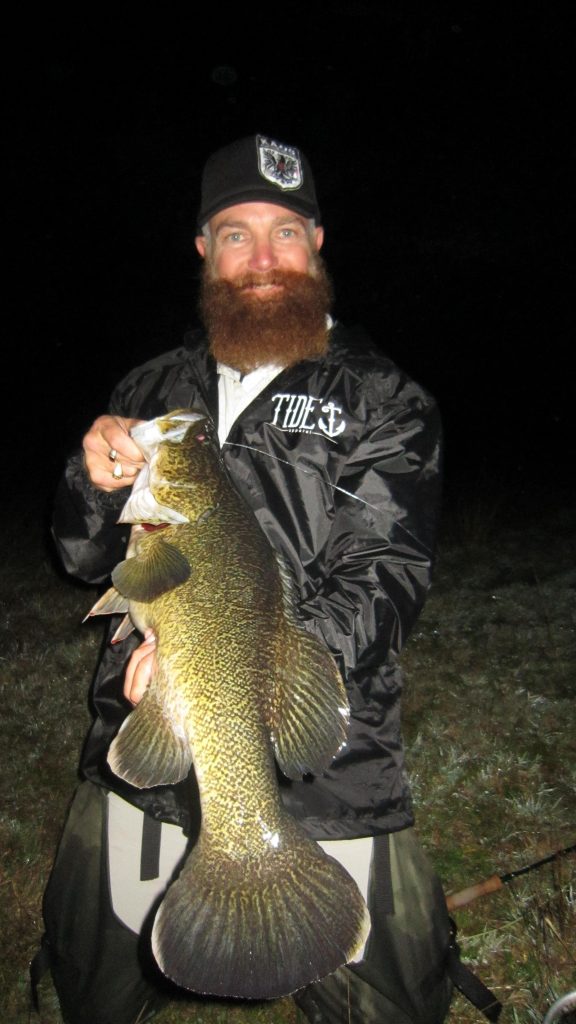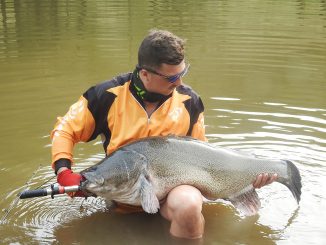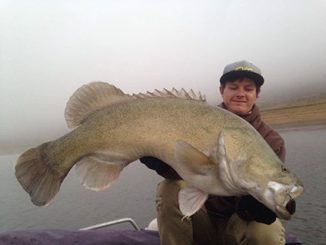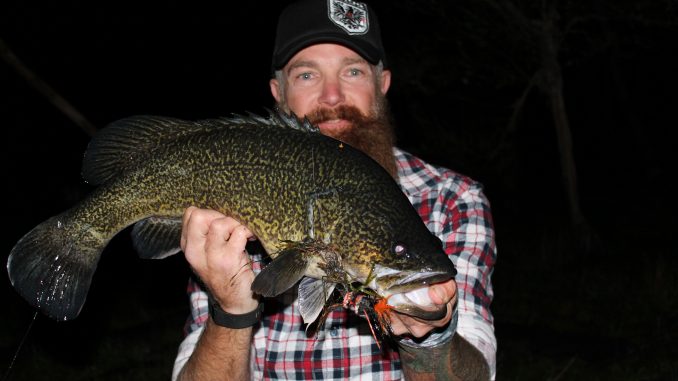
by Ross Virt •
Australia is a country that has it all: wilderness, dramatic scenery, crystal-clear streams full of Murray cod and the opportunity to take them on the surface with the fly rod!
The location options for this pursuit are endless, and the fishing is nothing short of addictive! Anglers who are fortunate enough to head off into the night in pursuit of the mighty Murray cod soon find themselves planning their next trip.
While the lake fishing can be pretty hot, you shouldn’t discount the river fishing either. Like fishing in lakes, fishing in rivers isn’t for the faint-hearted; in some locations you’ll have to deal with challenging wading and unpredictable conditions. Bear in mind too that the fishing can and will vary greatly from one trip to the next. However, whatever your priorities are, if you endure the elements you should come up tight to some good cod.
Structure
Lately, the water I’ve been targeting has been small and skinny with deep holes and a lot of structure. Casting long distance hasn’t been needed, as most of the casting has only been a few metres in front of me. It helps if you know the water you’re casting into before you fish it at night.
As for structure, you’re not just looking for timber, as there’s an array of different structure types to aim a fly at. Standing and submerged trees, root balls, logs, small or large branches, overhanging, floating weed, lily pads and cumbungi weed beds are just some of the structures you should be looking for.
In more rocky type streams, look for undercut banks, boulders, drop off points under the water and rock walls. These are all spots where Murray cod and golden perch will have a crack at a surface fly.
Water depth
The depth of the water is important while surface fishing, and as a general rule you shouldn’t waste your time casting flies of any kind into water over 20ft deep. Ideally, a depth from 1-6ft is ideal to cast a fly at. Once the water starts getting too deep, the fly won’t be in or even near the strike zone.
Techniques
Working your fly right to the rod tip, keeping tight and connected to the fly at all times, is imperative when fishing for cod with the fly. Sometimes it’s like the cod knows that the fly is just about to be lifted off the water, and quite often a huge explosion will occur at your feet and will scare the life out of you.
The technique is to cast your fly across the river, creek or out into the dam, landing it as close as possible to any structure. I begin to twitch my fly immediately with a strip-and-rip type retrieve. The action is often instant, and cod boil at the fly surface or sub-surface on landing.
Constantly moving the fly will entice more strikes from the fish than not moving it. However, you shouldn’t completely rule out the occasional pause. If you get some interest and a rejection, casting several times in the same location could produce another savage strike. Quite often the same fish will rise, boil and break the surface behind the fly time and time again, so keep casting.
PUTTING IT INTO PRACTICE
I’ve had many memorable sessions on cod at night, and one of my trips earlier this year was proof that persistence pays.
As I worked my way through the tiny pockets or larger pooled water, I sat the fly in the main current. Before long, in my peripheral vision I saw something huge and green roll though the surface at the bottom of the run. The fly came flickering back across the lie when I experienced that supreme, magical moment that sets Murray cod fishing apart from every other fishing pursuit! I made one more cast and a great table of black, glossy water rose up behind the fly, and suddenly the fly was snatched from the line.
Before I could react, the rod buckled over wildly in my hands. An impossible bow-wave ploughed through the water, followed by the frame of a truly huge cod rocketing though the water, heading back to his dungeon. I was filled with a mixture of fear and adrenaline. Not only was the hair on the back of my neck standing up – my whole body was covered with goose bumps.
Alone in the darkness, I scooted along the bank, retrieving the backing quickly as possible. As I watched the water, I was amazed to see a huge flank flash by as the cod bolted for home again. As the minutes ticked by, my mind began to fill with ‘what ifs’. Were my knots right? Would the leader hold? Will it spit the hook? Every head shake raised my anxiety a few notches.
When I finally landed the fish, the relief was overwhelming. The fight that had seemed to last a lifetime was over. I took a moment to take some photos, because without them it would have felt very much like a dream.
After I released the fish, I was keen to keep going. I suspected that the action was going to be thick and fast, so I headed down to the next pool and immediately got a reaction. There were a number of swirls behind the fly over a couple of casts, and I persisted, pausing the fly and waiting for the weight on my rod. Nothing happened!
I stopped and tried to figure out where the fish had gone. After looking around I noticed some semi-submerged structure to my right, barely visible in the moonlight. I cast 1-2m past the log as I didn’t want to spook the fish. I retrieved and slowly twitched the fly right over the snag, and… BOOF! Game on! My heart rate went up to 180 beats a minute. After a great battle with short, blistering runs, I came out with a Murray cod looking at me reproachfully. My fishing partner bolted over to see a horse of a fish reclining in my net, contemplating its defeat.
I took a moment to take some photos (it’s difficult to take good photos at night but I’m working on it), and then released the fish back to the cold depths.
Persistence does pay off, and always think outside the square. If you’re fishing techniques don’t work, try something different.
Breathing
Being in the right state of mind for casting is important. You need to relax and not rush the cast, which sounds ridiculous, but you really need to calm yourself down and breath! You need to cast accurately at structure and bully these fish from their haunts. If you don’t, you’ll come out with less fish, if any. These guys need to be provoked.
Correct
Outfits
Tackle selection can be a matter of trial and error. Anything from an 8-10wt rod loaded with the appropriate fly line will suffice, whether it be floating, intermediate or fast-sinking. It all depends on how you wish to target your cod. A shooting weight forward head will assist you to haul out those huge flies, that we chuck at Murray cod.
Hook-setting
Hook-setting is manifested by hand with little controlled strip striking. This may not permanently set the hooks, but pulling the rod butt towards the body while stripping works well when the fish hits further from the rod tip, however when the cod detonates over the fly at the rod tip, lifting the rod and pulling the butt towards your body will work better.
Hooking up and setting the hooks are different things. Hook up is when the fish has done the job for you and it hits the fly so aggressively that the hook set happens automatically and there isn’t much more to do than fight the fish. Setting the hooks on the other hand, you need to feel the bite and perform the aforementioned motions at the correct time to hook the fish.
If the cod doesn’t stay connected, take the slack up and start retrieving the fly slowly again, and it may entice another quick attack out of sheer aggression. Make sure to continue to work the fly right to the rod tip, and belt out another cast in the same direction. I tend to repeat cast after an explosion up to 10 times, and if there’s no inquires, I will move on, but I’ll remember that spot and have a cheeky cast or two on the way back.
Equipment
While walking the banks night or day, I carry a light weight back pack which contains a camera, fly box, pliers, leader material, water, torch, a measuring mat and my landing net that I have clipped to the back of the back pack for easy access.
It seems a lot, and it can be heavy, but all this stuff comes in handy. Walking distance and the amount of casting you do will vary on each trip, ad it pays to be prepared for any conditions you many come across.
A small First Aid kit is handy, as you never know what may happen while out and about. I like to keep my mobile phone in a water tight case along with the camera. The last thing you don’t need is your prized shot gone if you fall in the drink.
Remember to let someone know where you’re going for the night; so if there is any trouble while out, the right authority can start searching in the right spot!
Once hooked into these fish on the long wand, you’ll soon realise what all the fuss about is! Epic fights, blistering short runs and explosive topwater strikes are all part of a cod on fly session. Now’s the time to do it, so what are you waiting for?
Top 6 Murray cod flies
Fatboy Fly
Mega Dobson
Kaos Cod Skull
Gartside Gurgler
Kaos Codzooka
Dahlberg Mega Diver
* All flies can be tied on 4/0-7/0 hooks, depending on the water you’re fishing

